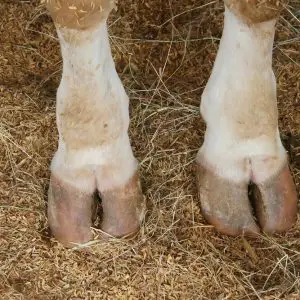A common treat found in most pet stores, pigs ears for dogs are inexpensive and irresistible to our canine companions. But how are they produced? Are they really a healthy option when it comes to dog treats? And if so, why? This article takes a deep dive into the subject, answering all these questions and more!
Key facts
Pig ear treats can be nutritious and delicious treats for your dog to enjoy on a moderated basis.
They can be beneficial to your pet’s health, especially dental health
Supervise your dog to avoid them swallowing pieces which could cause an obstruction.
Avoid pigs ears if your dog is still a puppy, overweight or prone to bouts of pancreatitis.
Most healthy adult dogs can safely enjoy one pig ear per week as a special treat for them.
What Are Pigs Ears for Dogs?
Pig ears are a natural dog treat, humanely harvested as a by-product from the farming industry. This ensures less of the pig goes to waste.
The part of the ear which is used is the pinna; the flap of the ear. The pinna is mainly comprised of cartilage and skin, with very little muscle. Therefore it is not like normal meat. Cartilage is a firm, yet flexible, connective tissue which is found in the ears, nose, at the end of ribs, and inside joints.
Once an ear has been harvested, it goes through a process of blanching in boiling water for 30 seconds, followed by rapid cooling in ice water. This removes all the remaining hair. After drying, it is then dehydrated either on a dehydration rack, in an oven at a low temperature, or in a smoker for extra flavour. This process can take between four and 24 hours, depending on which method is used.
Once fully dehydrated, they will be a treat that your dog won’t be able to resist.
Always read the label!
Not always natural…
Not every product sold as a “pig ear” is as natural as you might think. Some products might actually be rawhide shaped to look like a pig’s ear. Others might have additives like liquid smoke or unnecessary preservatives. And they might be sourced from places with poor animal welfare. Always read the label before buying
Benefits of Pigs Ears for Dogs
Pig ears are highly nutritious, but they should always be given as a treat rather than as part of a routine diet. This is for two reasons; firstly, they are not balanced in minerals and vitamins like a diet should be. And secondly, they are high in fat. Therefore, if given excessively, they may contribute to obesity. However, some fat is a good thing, as dogs need up to 20% of their diet to be made up of fats.
In addition to fat, the other nutrient that is found in pig ears is protein (almost 70% of a pig’s ear is protein). Protein is made up of chains of amino acids, which are the building blocks of all structural parts of the body, such as muscles, enzymes and antibodies. They are essential for basic functions in life, as well as effective immunity.
Pig’s Ear Nutrition
Because pig ears have a large hide content, they are tough to chew and require some effort to eat. With that being said, they are not as tough as cow hide, and therefore do not cause excessive abrasion on the gums. The toughness is a good thing as the continuous chewing action will remove plaque and tartar from your dog’s teeth.
Plaque and tartar are formed because of a build-up of food material and bacteria on the base of the teeth. As a result, the gums react and become inflamed, leading to a condition called gingivitis. If this gets out of control, the ligaments which hold the teeth to the gums can become weakened and teeth start falling out.
But the good news is giving occasional pig ear can aid in keeping the teeth clean and prevent dental disease.
Disadvantages & Risks of Pig Ears for Dogs
Feed Under Supervision
If your dog chews off big chunks then they can pose a risk of choking or obstruction so it’s generally advisable to supervise them. It’s also worth knowing the provenance of pig’s ears as if they have been processed poorly they can carry salmonella.
If given freely without care, pig ears can be detrimental to your dog’s health, and therefore some dogs should not be given them.
Obesity & Pancreatitis
Because of the high fat content, dogs who are struggling with their weight should not be allowed to have pig ears. Obesity is a major welfare problem, and can be linked to diseases such as osteoarthritis, diabetes and liver failure.
Also, a large amount of fat ingestion can trigger a disease called pancreatitis, in some dogs. The pancreas is an organ which produces enzymes which aid to digest food. When a dog has pancreatitis, the enzymes begin digesting the pancreas itself, leading to vomiting, diarrhoea and extreme abdominal pain. If a dog has had pancreatitis before, they are at a higher risk of developing it again, and therefore if your dog is a sufferer of pancreatitis, then pig ears will not be for him.
Salmonella
There have also been Salmonella contamination scares in pig ear treats. Approximately 4% of commercially produced pig ears contain Salmonella. A Salmonella infection can cause vomiting and diarrhoea in your dog, as well as in humans.
But if you source your pig ears from reliable places, such as butchers, reputable pet stores and veterinary clinics, then they are less likely to be contaminated.
Risk of Intestinal Obstruction
Finally, pig ears can cause obstructions in the gastrointestinal system if large pieces are swallowed. With all treats which are hard and have the ability to break into pieces, pieces can be swallowed and become stuck in the oesophagus, stomach or intestines. Blockages can be extremely serious, and cause vomiting, abdominal pain, and potentially gut perforations. Therefore, it is very important that any dog eating a pig ear is supervised.
FAQs About Pigs Ears for Dogs
Pig’s Ears for Puppies

It is not recommended that puppies are given pig ears. This is because the high fat content may lead to gastrointestinal upsets, such as vomiting, diarrhoea and gut discomfort.
Alternatives to Pigs Ears
There are several pig ear alternatives available on the market. If you wish to stick to pig ears, but in a slightly different form, some pet stores will sell them as rolls, which your dog can easily carry around. Because these are much thicker, they are considerably longer lasting.
If you wish to give your dog a different chew which is still natural and healthy, knuckle bones and antlers are both options that you will find in pet stores. However, knuckle bones can pose many health concerns to your dog, such as splintering and breaking off pieces which can cause blockages. Antlers are significantly safer, as they will not break or splinter, and they will also last for many months instead of simply seconds. Unfortunately, antlers are considerably more expensive than pig ears.
Rawhide chews are also commonly found in pet stores, in the same section as the pig ears. They may initially appear as a more attractive option, as they do not smell and are also made from animal by-products. However, the reality is less attractive. Rawhide is produced from a manufacturing process which can leave many chemicals still in the chew, which may be detrimental to your dog, so it is far less natural than it originally appears. In addition, it digests much slower in the gut, and can easily cause blockages if large pieces are swallowed.
FAQs
Pig’s ears are great for your dog’s dental health as the chewing action and the abrasion help remove plaque and tartar. And they are not so touch that can can hurt your dog’s gums in the way something like cow hide might.
Yes, pig’s ears are generally considered safe for dogs though there are some risks. If your dog bites of large chunks they could cause intestinal obstruction. Also, if you don’t know the provenance of a pig’s ear, it may contain salmonella. Additionally, if your dog is overweight, you shouldn’t feed them a pig’s ear because of the high fat content.
Much like any natural dried animal product, pig ears do have a meaty odour to them. This odour is one of the reasons why dogs are so attracted to them. For some people this smell will not matter, but if you are worried about the meaty smell sticking to your carpet and furniture, it is best to only offer your dog pig ears outside or in rooms with hard floors.
Pig ears are also fairly greasy compared to other similar treats on the market, which is because of their high fat content. This is another reason why you may not want your dog chewing them on carpet or furniture.
Pig ears should be given in moderation. As a recommended guideline, a medium sized dog should not have more than one pig ear per week. Remember that pig ears are not calorie free, and so the amount of food should be slightly adjusted on that day to avoid an increase in the number of daily calories above what is recommended.
If you’re looking for a long-lasting treat to keep your dog entertained for hours, pig ears may not be for your dog! A smaller dog, or one with a more delicate chewing action, may take a fairly long time to get through a pig ear. However, an excited middle or large breed dog with a healthy appetite is likely to get through it in under five minutes.
Pig ears, per se, are not the cause of any behaviour problems, however if you have a dog who is possessive over food then they may growl or snap if you try to take a pig ear away from them.
This behaviour stems from your dog’s attitude towards the hierarchy of the household. Dogs see their owners as part of their pack. Dominant dogs always eat first in a pack, and therefore if your dog feels he must warn you from coming near his food, this means he thinks he is higher in the hierarchy than you are.
If this is a case, you should consult a canine behaviourist to understand ways to ensure your dog sees you as their master, rather than their equal or beneath them.









